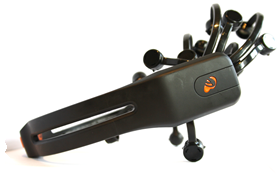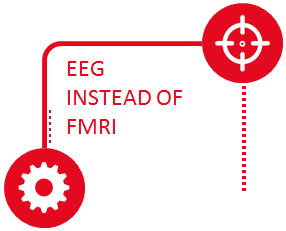There are two ways to visualize what goes on in the brain. One is an Electro Encephalogram or EEG, which measures brain activity that takes the form of electric pulses. Only a simple device is needed to measure these electrical pulses in the brain, no more complex and bothersome than a headphone. An EEG can detect changes in electrical activity within a millisecond. After careful and thorough evaluations of many different brain wave measurement approaches, WHY5 Research’s EVALUATE team is confident that EEG is the best tool for providing functionally useful neurodiagnostics data.
 Another option however, is functional Magnetic Resonance Imaging (fMRI). “In our blood, oxygen is transported by hemoglobin molecules,” explains radiologist and EVALUATE expert Dr. Luc Denis. “When a brain zone is activated, the blood in the zone will use more oxygen. However, it takes up to 5 seconds before the fMRI can detect a change in the brain, whereas an EEG senses brain activity within milliseconds.” According to Madeleine Janssens, using an fMRI for neuromarketing has significant disadvantages. “An fMRI is intrusive since the research usually occurs in a hospital or clinic, being the place where these highly expensive machines are located. A medical setting is somewhat sterile, unpleasant and maybe even destabilizing because respondents lie down in a narrow chamber to be monitored. This does not create a consumer experience that is similar to real life decision making, on the contrary.”
Another option however, is functional Magnetic Resonance Imaging (fMRI). “In our blood, oxygen is transported by hemoglobin molecules,” explains radiologist and EVALUATE expert Dr. Luc Denis. “When a brain zone is activated, the blood in the zone will use more oxygen. However, it takes up to 5 seconds before the fMRI can detect a change in the brain, whereas an EEG senses brain activity within milliseconds.” According to Madeleine Janssens, using an fMRI for neuromarketing has significant disadvantages. “An fMRI is intrusive since the research usually occurs in a hospital or clinic, being the place where these highly expensive machines are located. A medical setting is somewhat sterile, unpleasant and maybe even destabilizing because respondents lie down in a narrow chamber to be monitored. This does not create a consumer experience that is similar to real life decision making, on the contrary.”
 When using an fMRI, the general practice is to expose respondents to each marketing stimulus at least three times in order to get reliable results. However, if you unexpectedly shout at a person one time (boo!), his reaction will be spontaneous. If you do it a second time, he will be prepared and not repeat his original reaction. The intensity of his response diminishes each time he is exposed to the stimulus. Naturally, the average result will be less accurate. So, the suggestion that stimuli need to be shown multiple times is a myth.
When using an fMRI, the general practice is to expose respondents to each marketing stimulus at least three times in order to get reliable results. However, if you unexpectedly shout at a person one time (boo!), his reaction will be spontaneous. If you do it a second time, he will be prepared and not repeat his original reaction. The intensity of his response diminishes each time he is exposed to the stimulus. Naturally, the average result will be less accurate. So, the suggestion that stimuli need to be shown multiple times is a myth.
Madeleine Janssens continues, “Using an fMRI is time consuming and expensive. As EEG measurement provides us with an objective assessment of neuromarketing without having to put up with all the fMRI-disadvantages, we have clearly opted to use EEG. An fMRI may be OK for medical use, but not to understand consumers’ reaction to marketing stimuli in a (near) real life context.”
Dr. Luc Denis states further that “On top of that it is also a myth that complex brain processes like emotions and particular behaviour (such as purchase) can be precisely pinpointed in the human brain. If this was the case, psychiatry would be light-years ahead of where it is now”


.png)




